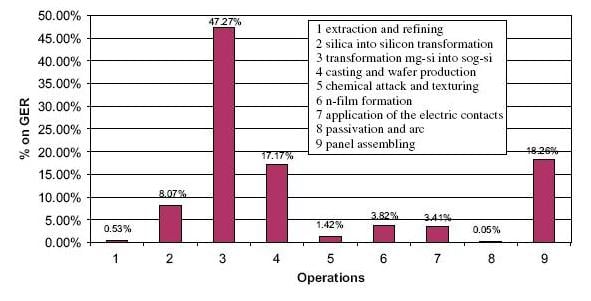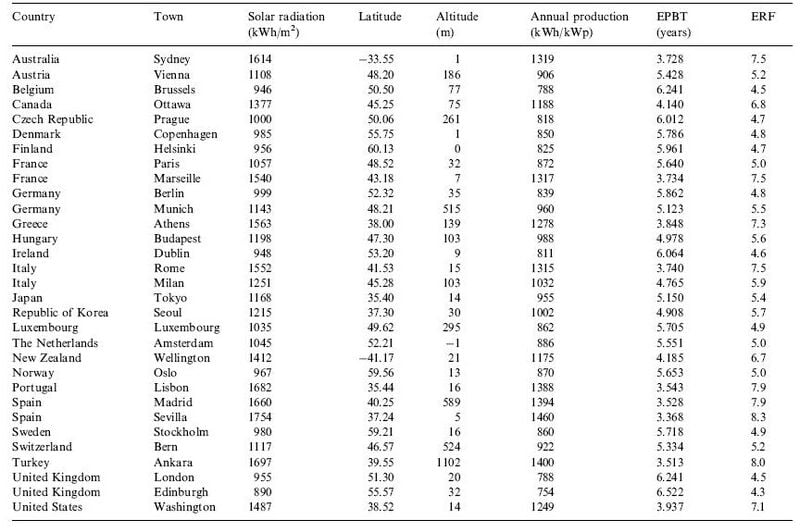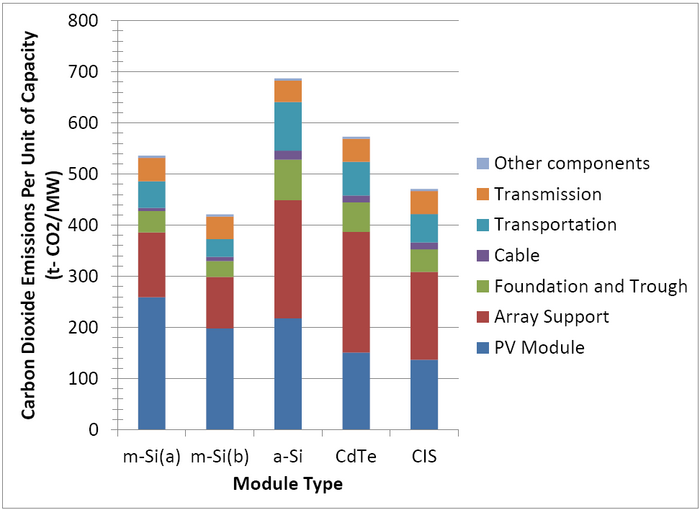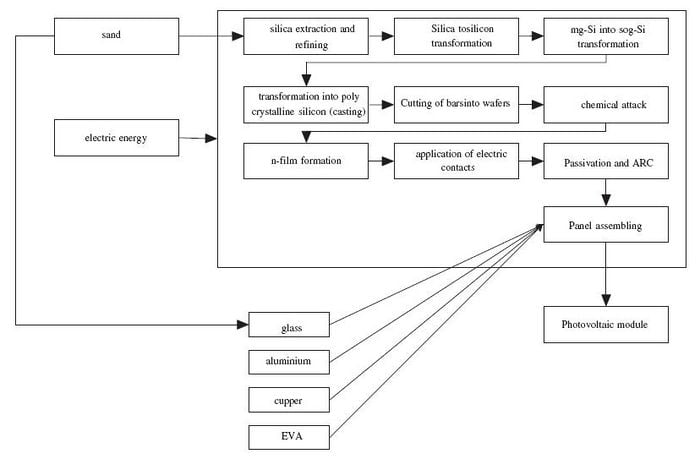Nathan.Chase (talk | contribs) |
Nathan.Chase (talk | contribs) No edit summary |
||
| Line 25: | Line 25: | ||
PV modules require significant amount of resources to produce. While there is this high upfront resource cost overtime, the panels generate large amount of rewnewable electricity from sun light. Where the panels are installed changes the amount and intensity of the solar energy reaching the panels. Cloudy climates and higher latitude climates see less solar energy over a year than sunny deserts near the equator. Despite this discrepancy in solar climates solar panels have Energy Pay Back Times (EPBT) well below the average panel life of 20-30 years. As shown in figure 2 the EPBT varies between 3 and 6 years. | PV modules require significant amount of resources to produce. While there is this high upfront resource cost overtime, the panels generate large amount of rewnewable electricity from sun light. Where the panels are installed changes the amount and intensity of the solar energy reaching the panels. Cloudy climates and higher latitude climates see less solar energy over a year than sunny deserts near the equator. Despite this discrepancy in solar climates solar panels have Energy Pay Back Times (EPBT) well below the average panel life of 20-30 years. As shown in figure 2 the EPBT varies between 3 and 6 years. | ||
[[Image:Energy_Payback_Time.jpg|thumb|center| | [[Image:Energy_Payback_Time.jpg|thumb|center|800px|Figure 2: Energy Pay Back Times (EPBT) and Energy Return Factor (ERF) of PV modules installed in various locations around the world(Stoppato, 2006).]] | ||
==Lifecycle Carbon Dioxide Emissions of Photovoltaics== | ==Lifecycle Carbon Dioxide Emissions of Photovoltaics== | ||
Revision as of 21:52, 22 April 2010

Background
Alternative energy technologies such as photovoltaic panels are becoming more popular around the world. In 2008, for the first time, worldwide investment in alternative energy sources drew more investors than fossil fuels, netting $155 billion in net capital against $110 billion of new investment in oil, natural gas and coal. Solar power alone generated $6.5 billion in worldwide revenue in 2004, and is expected to almost triple that with projected revenues of $18.5 billion for 2010.
Alternative energy technologies are becoming increasingly popular due to greater awareness and concerns regarding pollution, and global climate change throughout the world. Alternative energy technologies offer a new option for obtaining useful energy from sources that have less environmental impact on the planet.
This article explores all of the environmental impacts associated with the production and lifetime use of silicon photovoltaic (PV) panels.
What is a Life Cycle Analysis (LCA)?
A Life Cycle Analysis (LCA) evaluates the environmental impacts of a product or process from production to disposal (Fthenakis et al., 2005). An LCA investigates the material and energy inputs required to produce and use a product, the emissions associated with its use, and the environmental impacts of disposal or recycling. The LCA may also investigate external costs such as environmental mitigation that is made necessary by the production or use of a product (Fthenakis and Alesma, 2006).
Brief History of Solar Power
The first photovoltaic cell was built by Charles Fritts, who built a 30-cm cell from selenium and gold in 1883 (Hegedus and Luque, 2003). Modern silicon photovoltaic technology was discovered in 1954 by researchers in Bell Labs, who accidentally developed the pn-junction that enables photovoltaics to produce useful electricity (Goetzberger and Hoffmann, 2005). In 1958, NASA began using photovoltaics as backup power systems for its satellites (Hegedus and Luque, 2003). The first solar-powered residence was constructed at the University of Delaware in 1973, and the first megawatt-scale photovoltaic project was installed in California in 1984 (Hegedus and Luque, 2003).
Lifecycle of Energy
A solar panel requires energy to produce, transport, and install which is offset overtime by the energy the panel produces. THis section looks into the energy side of the Lifecyle Analysis of photovoltaics.
Energy Use in Production and Installation
As discussed in the Energy and Materials Use section below, a very small percent of the total energy used to generate and install photovoltaics comes from the installation and transportation of the final produce. manufacturing photovoltaics is overwhelmingly the most energy intensive step of installed PV arrays. As seen in figure 1 large amounts of energy are used to convert silica sand into the high purity silica required for photovoltaic wafers. The assembling of the PV modules is another resource intensive step with the addition of high energy content aluminum framing and glass roofing.

Energy Payback
PV modules require significant amount of resources to produce. While there is this high upfront resource cost overtime, the panels generate large amount of rewnewable electricity from sun light. Where the panels are installed changes the amount and intensity of the solar energy reaching the panels. Cloudy climates and higher latitude climates see less solar energy over a year than sunny deserts near the equator. Despite this discrepancy in solar climates solar panels have Energy Pay Back Times (EPBT) well below the average panel life of 20-30 years. As shown in figure 2 the EPBT varies between 3 and 6 years.

Lifecycle Carbon Dioxide Emissions of Photovoltaics
Lifecycle carbon dioxide emissions refer to the emissions caused by the production, transportation, or installation of materials related to photovoltaic systems. In addition to the modules themselves, the typical installation includes electrical cable and a metal rack. Ground-mounted photovoltaic systems also include a concrete foundation. Remote installations may require additional infrastructure for transmission of electricity to the local electrical grid. In addition to materials, a life cycle analysis should include carbon dioxide emitted from vehicles during the transportation of photovoltaic modules between the factory, the warehouse, and the installation site. The graph below compares the relative contributions of these factors to the lifetime carbon dioxide impacts of five types of photovoltaic modules (Ito et al., 2007).

Production
The environmental impact of a silicon photovoltaic module involves the production of three main components: the frame, the module, and balance-of-system components such as the rack and inverter (Fthenakis and Alsema, 2006). Greenhouse gases are caused mostly by module production (81%), followed by the balance of system (12%) and frame (7%) (Fthenakis and Alsema, 2006).

Energy and Materials Usage
Silicon PV panels generate carbon emissions through transportation (between the factory, the distributor, and the installation site) and also through the additional materials needed for installation.
Transportation
Transportation accounts for about 9% of lifecycle emissions of photovoltaics (Ito et al., 2007). Photovoltaic modules, racks, and balance-of-system hardware (such as cables, connectors, and mounting brackets) are frequently produced overseas and transported to the United States by ship (Kato et al., 2007). Within the United States, these components are transported by truck to distribution centers and eventually to the installation site.
Installation
Emissions associated with installation include vehicle emissions, material consumption, and electricity consumption associated with local construction activities to install the system. These activities generate less than 1% of total lifecycle emissions of the photovoltaic system (Kato et al., 2007).
Waste Generated
The disposal of silicon photovoltaic modules has not caused significant impacts because large-scale installations have only been in use since the mid-1980's and photovoltaic modules have lifetimes of at least 30 years (Hegedus and Luque, 2003). Fthenakis et al. (2005) specifically identified a lack of available data on the disposal or recycling of photovoltaic modules, so this topic warrants more thourough investigation.
Air and Water Emissions
There are no air or water emissions generated during the use of PV modules. Airsheds are impacted during the construction of PV modules from solvent and alcohol emissions that contribute to photochemical ozone formation. Watersheds are impacted by the construction of of modules from extraction of natural resources such as quartz, silicon carbide, glass, and aluminum. Overall, replacement of current worldwide grid electricity with central PV systems would lead to 89-98% reductions in greenhouse gas emissions, criteria pollutants, heavy metals, and radioactive species (Fthenakis et al., 2008).
Comparison to Other Energy Sources
Total lifecycle emissoins associated with photovoltaic energy production are higher than those of nuclear power but lower than those of fossil fuel energy production. Lifecycle greenhouse gas emissions of several energy generation technologies are listed below: (Fthenakis and Alsema 2006).
- Silicon PV: 45 g/kWh
- Coal: 900 g/kWh
- Natural gas: 400-439 g/kWh
- Nuclear: 20-40 g/kWh
Conclusions
Silicon PV panels have a low life cycle environmental impact compared to most conventional forms of energy such as coal and natural gas. The greatest carbon emissions caused by the use of PV panels are those associated with module production.
References
[http://books.google.com/books?id=QF8jDTSByTgC&pg=PA2&dq=history+of+photovoltaics&hl=en&ei=jczJS73MC4G6swOuqdzEAw&sa=X&oi=book_result&ct=result&resnum=2&ved=0CEQQ6AEwAQ#v=onepage&q=history%20of%20photovoltaics&f=false Goetzberger, A., and V. U. Ho�mann (2005), Photovoltaic Solar Energy Generation, Springer, New York, NY.]
Life cycle assessment of photovoltaic electricity generation, A. Stoppato, Energy, Volume 33, Issue 2, February 2008, Pages 224-232